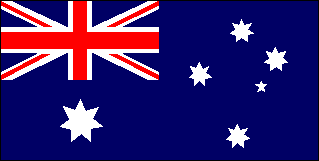Our Australian Sister Society:
The Astronomical Society of Albury-Wodonga (ASAW)
Click Here to Enlarge ASAW
Click Here to Enlarge CFAS
A Warm Welcome and Hello to our Mates Down Under!
THE SISTER PROJECT
In the fall of 2004, Robert Price of the Australian Society suggested to Sam Bissette of the American Society that the two organizations form a "Sister Society" relationship. These two amateur astronomical societies are very similar in size, programs, and activities with the unusual situation that each is located in the two different hemispheres of the Northern Hemisphere and the Southern Hemisphere. It is believed that an ongoing series of interaction between the two groups would be interesting and informative to their respective memberships. A presentation to the memberships of both groups received a strong measure of support and the planning began.
Sam Bissette and Bob Price, who will represent the AWAS, had a ten year friendship which began in 1995 when they collaborated on a research study of the Southern Hemisphere involving the astromicroscopy method of astronomical observing originated by Bissette. Sam passed away in November of 2005, leaving this as one of his many contributions to our Society.
Click here to read the News Release: ASAW-CFAS News Release - January, 2005
THE ASTRONOMICAL SOCIETY OF ALBURY-WODONGA
The ASAW draws members from the twin cities of Albury, which is in the State of New South Wales and Wodonga, which is in the State of Victoria, and the surrounding smaller towns within a wide regional area. The Club has 30-plus members with a wide range of skills and knowledge that enables them to undertake interesting meetings and activities. They recently finished building 18 x 114 mm (4.5") Dobsonian telescopes.
Click here to visit the ASAW website: The Astronomical Society of Albury-Wodonga.

Nyagag durd mayo (Aboriginal for 'Look to the sky')
THE PROGRAM
- Each month an exchange would be made of the minutes of each club's meeting.
- The Internet web sites of each society would be linked.
- The monthly newsletters of each society would be shared with each other.
- A roster of the membership of each society would be transmitted to the other.
- A digital group photograph of each society's members would be shared.
- A list of the astronomical observing equipment used by each club's members would be provided each society.
- International travel of society members would provide opportunities for visitation and hosting by society members.
- Exchange of astronomical research, images and published documents.
- Education of members in regard to Northern and Southern hemisphere celestial objects and specific astronomical projects being undertaken, such as minimization of obtrusive lighting and light pollution.
- Inform the local governmental authorities of the creation of this sister society relationship as it might be of interest in relations in other fields. A letter to the respective mayors enclosing a copy of this document would be in order, and also containing the names and address of their counterparts.
- An international news release, containing a copy of this document, would be issued with each Society handling distribution for their country.
- Consider adding other appropriate activities from time to time as they may come to mind.
Both societies share the belief that this Sister Society (sister club, informally) relationship is quite worthwhile and will be a pleasant addition to the activities of each organization. We also hope that there are other astronomical clubs and societies already doing this but if not that our attempt will be helpful as an example to follow.

